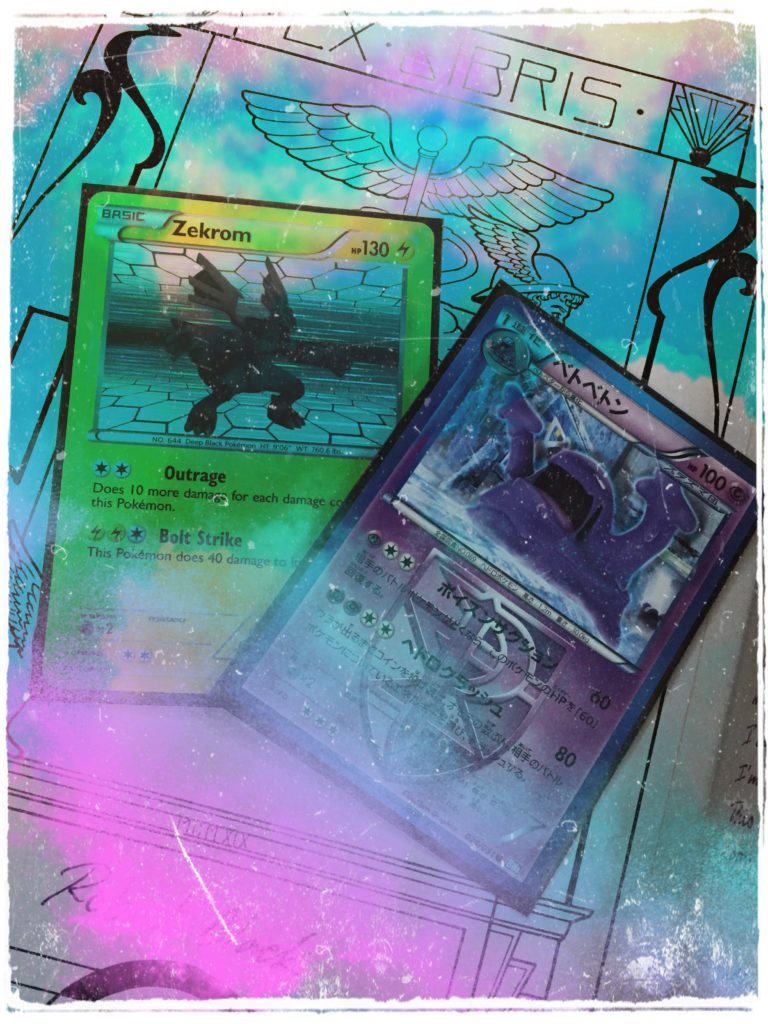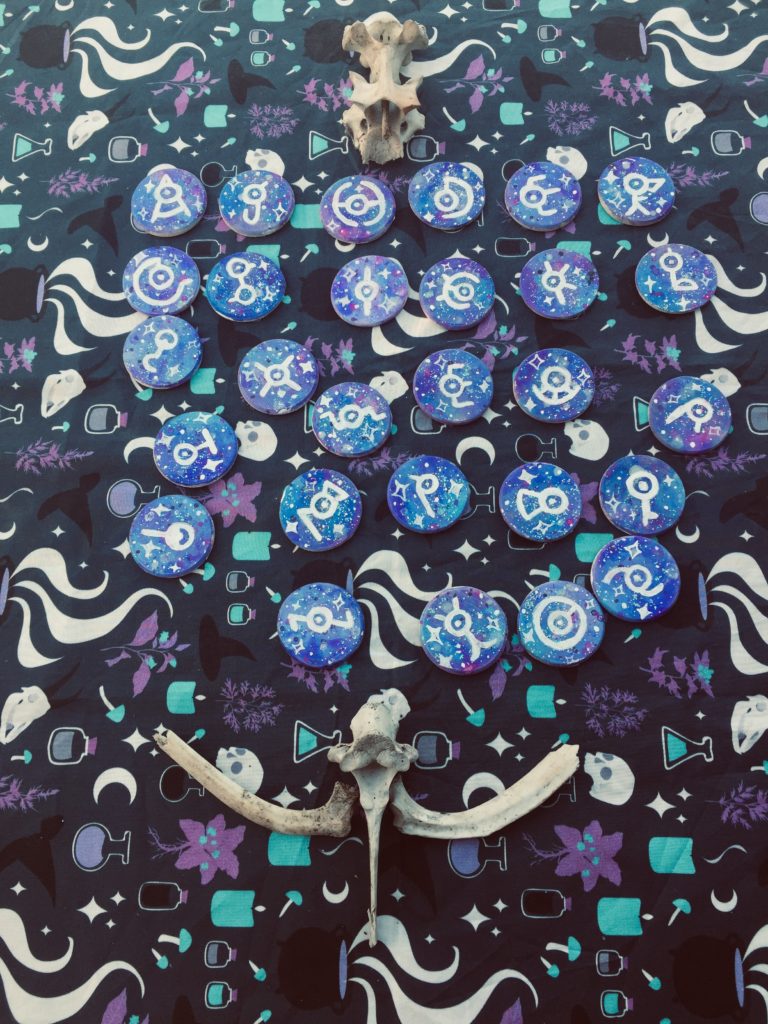If you delve into the pop magick circles of Facebookland, there’s a remote possibility that you’ve seen a post on Pokemancy at some point over the past year.

Derived from the root Pokémon + the suffix mancy
-word-forming element of Greek origin meaning “divination by means of,” from Old French -mancie, from Late Latin -mantia, from Greek manteia “oracle, divination,” from mantis mantis “one who divines, a seer, prophet; one touched by divine madness,” from mainesthai “be inspired,” which is related to menos “passion, spirit,” from PIE *mnyo-, suffixed form of root *men- “to think,” with derivatives referring to qualities and states of mind or thought.
Growing up, Pokémon was frowned upon by a lot of the more vigorously fundamentalist Christian folks, amid claims of Pokémon being demonic in origin. They were not totally inaccurate, although I find their stance questionable. Having a team of pokemon is not dissimilar to creating your own hierarchy or pantheon, much like the demonic hierarchies.
Pokémon draws inspiration from many cultures and mythos, different philosophies and ideologies, and uses symbolism any well learned mage should be competent enough to pick up. From the Hopkinsville goblin in North America, to Loki’s children, from Japanese yokai to Hawaiian night marchers, from Bruce Lee, to the concepts of yin, yang, and wuji. These Pokémon represent aspects of the self, divine principles Each Pokémon is equipped with a typing, an element, and abilities which work as easy references in deciding which Pokémon to work with.
In Pokémon games you are generally started with a Pokémon of one of 3 of the 4 elements, fire, water, and earth, and in total, as of this moment, there are 18 elemental types of Pokémon, which are as follows: Fire, Water, Grass, Electric, Psychic, Steel, Normal, Fairy, Dark, Flying, Ghost, Poison, Ice, Ground, Rock, Dragon, Fighting and Bug. Each of these elements can correspond to a blend of the 4 elements and spirit, in different combinations.
As of this moment there are about 11,000 English Pokémon cards, and almost 7,000 Japanese ones, but the number is increasing with the release of pkmn Sw/Sh.
Within the hierarchy of Pokémon, there are legendary Pokémon, who act as godforms/deities in the Pokémon Multiverse. Each one of these is imbued with a primal power of great creative and destructed potential, and are worshipped in various regions for their power and feats.. Some of these godforms reside in the physical world, and dwell among mankind, usually isolated so they don’t cause a ruckus. Others reside in their own dimensions, making research on them slightly more difficult to observe. These we can gain familiarity with by reading their origin myths, and connecting with them. Most of these legendary Pokémon are genderless, with the exception of a few gendered species.
After the legendaries in the hierarchy come the Unown, although really they have just as much creative potential as Arceus, who is heralded as the creator deity.. They too dwell in their own dimension, although they frequent tombs and ruins in the Pokémon world, oft disguising themselves as hieroglyphs. The unown in their own dimension are unmanifest, but when they come together, a great power emerges. These unown are based off of both Greek and Cryllic alphabet and aesthetic, and number 28- 26 letters, and exclamation and question marks. Just like in our dimension, these letters have meanings, and when combined, work well as gliphs/runes/spells/sigils, what have you. They communicate through both telepathy and using electromagnetic waves. They were present at the time Arceus created the realms, but didn’t take part in the actual manifestation, for reasons unbeknownst to myself.
Next down the hierarchy, IMO, are the Pokémon that can move between worlds and realities. Some Pokédex entries show certain species of Pokémon being capable of walking between the realms of Pokémon into our present reality, in varied locations in South America, China, and others. Other Pokémon have the power to travel through space into a different reality known as Ultra Space, and my personal favorite are the slew of Pokémon who can transport people to the spirit realm, known in Pokémon as the ghost world/ghost realm. These Pokémon are the guardians of liminal spaces, and are regarded as psychopomps, mediators, and shamanic figures.
Mythical Pokémon and Ultrabeasts are tied for position, being powerful and rare, but not as rare as elusive legendaries. These Pokémon all have quests associated with them, and relate to parts of the mind- ego, higher self, etc.
Finally we have your extensive list of just about every other Pokémon, which are all cool in their own right, and have amazing origin stories, and differing abilities, but for all intents and purposes, aren’t really as rare as the others. Each one has merit, and each has extensive meaning for divinatory purposes.
When working with a Pokémon servitor, there is an important distinction of whether you want to work with a specific Pokémon, vs the Pokémon archetype- some are better than others. For instance, if you wanted help with money troubles, meowth would be a perfect choice- just not Jesse and James’, as he’s quite a blunder when it comes to using payday. In this instance you’d definitely want to invoke the meowth archetype, as they’re not totally hopeless and will give you real monetary opportunities, as opposed to sadly flinging bottlecaps at you. If you wanted to work with a Pokémon that exemplifies a particular trait you’re after, let’s say Ash-Greninja- it’s different than a standard greninja, being swifter, more powerful, and having the battle bond ability, making it able to mind meld and transform into a new form that takes on the likeness of its trainer. Ash’s greninja is a fierce protector, working alongside Zygarde in an attempt to save the world from an inky dark sickness.
This information comes from the Pokedex, common sense, personal experience, and a decent grasp of occult symbolism, and I hope it finds you well, and can be of some use to you.
I’d like to invite you to explore the unown, as I use their glyphs in divination as well. They have been around as long as, yet separate from the creator Arceus. They dwell in their own dimension, yet sometimes frequent old tombs and ruins, pretending to be hieroglyphs. In their solo state, they may seem weak, only knowing one move, but that one move has a deep meaning.
In their dormant state, unown are unmanifest, unobservable, yet when they come together, the creative potential reaches magnitudes almost unheard of.
The unmanifest is the Absolute, the pure and formless ground of being from which creation and manifestation arise. As such, the unmanifested is free from change, the unmoved mover. It also, necessarily, cannot be comprehended or explained in terms of any manifest reality, neither mundane nor transcendent. The Absolute is the unknowable, undefinable, unfathomable, immutable, timeless, spaceless, indivisible, formless Omnipresent Divine Reality.
When unown come together, it is said an odd power emerges. Of course, when you combine letters, you make words, and with words you can create spells- it’s all in the name. Spell, ya know. Each letter has a meaning, a force behind it, both in the human world, but also when dealing with Pokémon. So we go from unmanifest, the ultimate pre potential, and then shift into chi, in our universe, circulating life energy.
It is known that the unown are based upon the Greek/ Phoenician alphabet, with 26 letters. Added to that are the punctuation marks ‘!’ and ‘?’ , giving a total of 28 varying forms. Visually some look similar to the cryllic alphabet.
Here’s the list game freak released of the unown and their meanings.
In Pokémon cards, you find various unown cards, each with a different word, or simple spell written upon them. Just as you would with rune staves, you can combine these to make glyphs and sigils.
Their use in divination would be similar to casting runes, and interpreting their meaning based on your own experience with the symbolism.
I’ll share my interpretations below, although you can feel free to seek your own meanings, as these are personal to me.
Unown glyph meanings in divination:
A- angry- conflict, confrontation
B- bear- motherhood, spirit, protection
C- chase- travel, wasting time, frivolity
D- direct- positive, continue, teach, hierophant
E- engage- action, pos/neg,
F- find- questions, answers, location
G- give- cups, fulfillment, generosity
H- help- be open to giving and receiving
I- increase- addition to the situation
J- join- community, friendship, work, orders
K- keep- stay to this path, selflessness/selfishness
L- laugh- medicine. Banishing , cleansing
M- make- pure creation, go out and do the thing
N- nuzzle- romance, lovers, hope, family
O- observe- no action required, just watch
P- preform- action, knight cards, work
Q- quicken- fast paced, changes, tower
R- reassure- everything’s gonna be okay, hope, the sun, the star
S- search- seeking, introspection, helping find things, spirituality
T- tell — communication, truth, spells,Mercury
U- undo- look to the past to help with issues in the future
V- vanish- disappear, lay low, introspection, hermit, solitude
W- want- manifest, the magician, ego
X- xxxx- null, no answer, not now
Y- yield- stop, pause, wait
Z- zoom- pay close attention to your surroundings, haste, travel, air and earth.
!- exclamation, strong answer, important
?- a question, unsure, unclear answer
Being a tad bit of an animist, these glyphs really do seem to have a personality all of their own- seriously mysterious, And slightly mischevious.
I hope this little bit of information might spark some curiosity in working with Pokémon in your own practice,
93
ursa.


